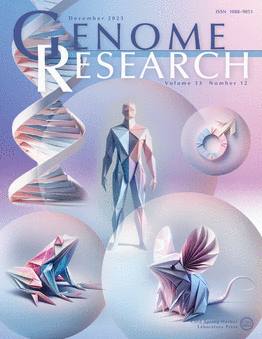不同类别的层相关结构域由抑制性组蛋白甲基化的不同模式定义
IF 5.5
2区 生物学
Q1 BIOCHEMISTRY & MOLECULAR BIOLOGY
引用次数: 0
摘要
基因组的很大一部分通过层相关结构域(LADs)与核外周相互作用,这是一个抑制区域,在基因组组织和基因调控中发挥重要作用。尽管做了很多工作,LAD的结构和调控还没有被完全理解,越来越多的研究已经确定了LAD内部的许多遗传和表观遗传差异,表明它们不是一个统一的群体。在这里,我们分析了来自同一小鼠群体的MEF细胞系中的层粘连蛋白B1、CBX1(也称为HP1B)、H3K9me3、H3K9me2、H3K27me3、H3K14ac、H3K27ac和H3K9ac,并根据这些特征的丰度和分布对LADs进行了聚类。我们发现LADs分为三组,每组都富含一组独特的组蛋白修饰和基因组特征。每一组由不同的异染色质修饰(H3K9me3、H3K9me2或H3K27me3)定义,这表明这三种标记在LAD染色质调控和层间关联中都起着重要作用。我们还发现了LAD边界的独特特征,包括H3K14ac的LAD边界特异性富集。这些结果揭示了LAD之间的重要区别,并突出了LAD结构和调节机制的多样性和复杂性。本文章由计算机程序翻译,如有差异,请以英文原文为准。
Distinct classes of lamina-associated domains are defined by differential patterns of repressive histone methylation
A large fraction of the genome interacts with the nuclear periphery through lamina-associated domains (LADs), repressive regions which play an important role in genome organization and gene regulation across development. Despite much work, LAD structure and regulation are not fully understood, and a mounting number of studies have identified numerous genetic and epigenetic differences within LADs, demonstrating they are not a uniform group. Here, we profile lamin B1, CBX1 (also known as HP1B), H3K9me3, H3K9me2, H3K27me3, H3K14ac, H3K27ac, and H3K9ac in MEF cell lines derived from the same mouse colony, and cluster LADs based on the abundance and distribution of these features across LADs. We find that LADs fall into three groups, each enriched in a unique set of histone modifications and genomic features. Each group is defined by a different heterochromatin modification (H3K9me3, H3K9me2, or H3K27me3), suggesting that all three of these marks play important roles in regulation of LAD chromatin and potentially of lamina association. We also discover unique features of LAD borders, including a LAD border–specific enrichment of H3K14ac. These results reveal important distinctions between LADs and highlight the rich diversity and complexity in LAD structure and regulatory mechanisms.
求助全文
通过发布文献求助,成功后即可免费获取论文全文。
去求助
来源期刊

Genome research
生物-生化与分子生物学
CiteScore
12.40
自引率
1.40%
发文量
140
审稿时长
6 months
期刊介绍:
Launched in 1995, Genome Research is an international, continuously published, peer-reviewed journal that focuses on research that provides novel insights into the genome biology of all organisms, including advances in genomic medicine.
Among the topics considered by the journal are genome structure and function, comparative genomics, molecular evolution, genome-scale quantitative and population genetics, proteomics, epigenomics, and systems biology. The journal also features exciting gene discoveries and reports of cutting-edge computational biology and high-throughput methodologies.
New data in these areas are published as research papers, or methods and resource reports that provide novel information on technologies or tools that will be of interest to a broad readership. Complete data sets are presented electronically on the journal''s web site where appropriate. The journal also provides Reviews, Perspectives, and Insight/Outlook articles, which present commentary on the latest advances published both here and elsewhere, placing such progress in its broader biological context.
 求助内容:
求助内容: 应助结果提醒方式:
应助结果提醒方式:


